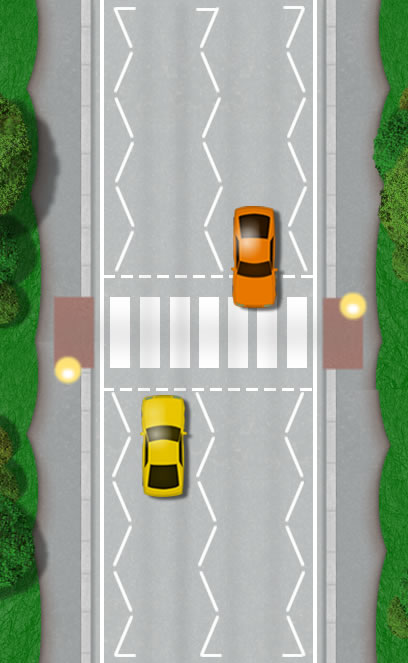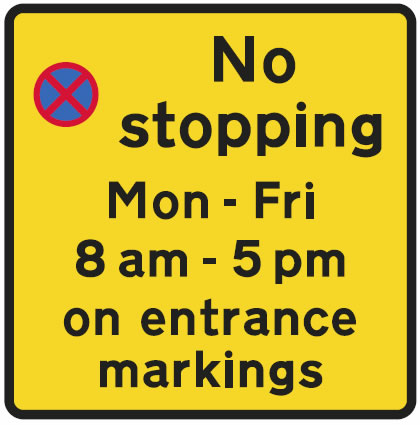Both yellow and white zig zag road line markings generally provide motorists with instructions that stopping on parking on the zig zag line area is prohibited.
To enable legal enforcement and the ability to issue motorists with a Penalty Charge Notice fine (PCN), yellow zig zag road markings often found outside of school entrances and police, ambulance or hospital entrances, a sign must be in place close to the yellow lines detailing the restriction or times of restriction.
Without the sign, yellow zig zag lines are not legally enforceable. See yellow zig zag lines for more information. White zig zag lines that are located at traffic lights and Zebra crossings however do not need a sign for enforcement.
White zig zag lines
White zig zags lines are classed as dual enforcement restriction, this means the council can issue tickets to vehicles parked in contravention, likewise the Police can also issue to vehicles parked in contravention. The only difference is the Police fine also carries penalty points. You cannot park on these at any time.

When were white zig zag lines first introduced?
The white zig zag lines indicating to motorists ‘no parking’ were placed at either side of the Zebra crossings in 1971, they were then added to Pelican crossings much later during the 1980s.
What do zig zag road markings mean?
Yellow zig zag lines can be located outside of the entrances to schools, hospitals, police and ambulance stations and inform motorists that this area must be kept clear from waiting or parking. Especially important at schools, they offer children a clear view of the road when crossing as no cars will be parked in such areas the zig zag lines are located.
White zig zag lines are placed either side of the pedestrian crossing areas at all UK pedestrian crossings. Prohibition of parking in the white zig zag area increases the safety of pedestrians crossing the road as they will have a clear view or the road in both directions.
An unobstructed view of the crossing for motorists is especially important at zebra crossings and light controlled crossings where the lights have changed to green for the motorists but a pedestrian may still be crossing – this can be particularly relevant to the elderly who may take longer to cross or children crossing at an inappropriate time.
Parking on zig zag lines
Yellow zig zag lines that have a sign in place are enforced by the local council who have powers to issue motorists with a Penalty charge Notice (PCN) fine which is enforced as a civil matter and not criminal.
A motorists is permitted to park on yellow zig zag lines outside of the times dictated on the sign. If no sign is present, the zig zag lines cannot be legally enforced. Penalty charge Notice fines for parking on white zig zag lines is in the higher region of £70 but is reduced by 50% if paid within the times displayed on the ticket. White zig zag road markings are enforced 24 hours a day, each day of the year and do not need a sign to enforce the no parking prohibition.
Parking prohibition is enforced by local councils who issue a PCN and the police who will issue a endorsable Fixed Penalty Notice (FPN) and will incur 3 penalty points on the offenders licence.
As parking on white zig zag lines puts pedestrians at risk, police will almost always issue a FPN without exceptions. Unlike yellow zig zag lines, there are no exceptions to stopping on white zig zag lines (other than to wait for pedestrians). The Fixed Penalty Notice issued by the police is £100 with 3 penalty points. If you refuse, you could take the matter to court. In some circumstances, you may be offered a driver retraining course. For further information on the types of zig zag lines found outside of schools and other government facilities, see:
Disputing a Penalty charge Notice or Fixed Penalty Notice
Road markings must be clear and in most cases follow a criteria for size, spacing and dimensions. A PCN or FPN can be withdrawn if the road markings do not comply with certain conditions.
Illegal yellow zig zag parking is enforced by local councils by which a local authority order is in place by use of road markings a time plate sign making it illegal to park during the times show on the sign. If there is no sign present, it is not enforceable and as these a dealt with local council, action is civil and not criminal, therefore the penalty is not endorsable.
Parking on zig zag lines, especially white zig zag lines if difficult to dispute a given penalty. Few exceptions are given. Disputing a penalty can result in tickets being cancelled if stopped because of an emergency such as helping a person who is injured for example.

Zig zag lines signs
Unlike white zig zag lines, yellow zig zag lines found outside of schools, hospitals and police and ambulance stations must have a time plate sign accompanying the lines to be legally enforceable.

Take the theory test road markings quiz
Test your road markings knowledge. When you feel confident in your ability to understand road markings, take the free road markings theory test quiz and test your knowledge. See Road markings theory test quiz.

If I only pulled over to allow oncoming traffic why have I been fined
Can you advise, on white zig zags at pelican crossings, is enforcement also undertaken if a vehicle is parked on the pavement next to the zig zags
Hello John,
The law applies to the carriageway only, but if a vehicle was parked in such a way to obscure the view of the crossing for drivers or for the pedestrians on the crossing, the vehicle owner may find themselves causing an offence of obstruction. Parking on pavements also has their own issues with the law, particularly in London where it’s prohibited.
I have stopped outside the school on a single yellow line oncoming traffic but before the zigzag line and the zigzag line time was not active ( restriction time 8:30 am to 10:30 am) and ( 2:30 PM to 4:00 PM) and I have stopped but not stepped out the car at 1:00 PM. will I get a penalty charge. A police van stopped for a while and then moved after 5 minutes. Any suggestions? If I get a penalty notice then can I contest the charge?
Hi Saqib,
If this was on two occasions and both were outside of the enforcement times listed on the sign, you have nothing to worry about. As a point of interest though, whether you stepped out of the car or not would be irrelevant.
Parked on path but over white zig zag lines for 2 min as I nipped into chemist and got to have a refresher course as the police was boad nothing to do what can I do as I don’t need this
Technically, in terms of white zig zag lines, the enforcement area remains on the carriageway and not the pavement. Were there other restrictions in place such as no waiting? You don’t have to take the driver retraining course, you could take it to court, but personally I would accept the driver retraining course (better to avoid prosecution). Ultimately it could be considered that you were causing an obstruction and hazard to pedestrians, particularly around a pedestrian crossing area.
Good day! Can you please explain me a little bit?
The zigzag markings at the church include the dividing line. The church has a bus stop. There is a bus which is taking out and receiving passengers. Is it possible to take the bus around crossing the zigzag?
Thank you very much!
Hi Eugenie,
Assuming these are white zigzag lines, you can overtake the bus providing the bus has not stopped within the zig zag area (controlled area). The actual controlled area on the same side of the road as the bus stop may have been shortened to make way for the bus stop – so technically the bus stop may not be within the controlled area.
If the bus has stopped within the controlled area but after the crossing, you can overtake it legally.
On the approach to a crossing, it is illegal to overtake any moving leading vehicle, or the leading vehicle which has stopped in compliance with the crossing area.
Hi there,
In terms of a two lane, one way street, if there are no cars or pedestrians are you allowed to CHANGE Lane over centre white zig zag markings. Ie merge from the left lane to the right.
The road in question has few places otherwise to change lanes before a carpark on the right.
So not overtaking OR parking, just changing Lane over the zig zag.
Many Thanks for your help.
Hello Callum,
Providing you aren’t overtaking, we are not aware of any legal provision that would prevent you from doing this but generally speaking, it wouldn’t be a good idea on the approach to a pedestrian crossing.
Hi, I wonder if you can help me.
We have a pelican crossing in our town on a one way street, which has white zig zags surrounding it. There is a layby area alongside (essentially a lane which is turns from parking, to double yellow lines) prior to the traffic lights, which have their own double yellow lines and is used by lorries for unloading stock to the adjacent shop, and occasionally by cars with a blue badge.
We recently parked there due to an emergency and were approached by a passing traffic warden who said that I was parked on zig zags which was an immediate fine unless we moved immediately.
Would the double yellow lines be the prevailing indicator of whether you can park in this parallel layby area (which ceases at the crossing), or the zig zags? We do have a blue badge and had parked here previously, assuming that as it has its own road markings, these superceded the zig zags.
Hi Kerri
Is the lane a separate road to the one which has the white zig zags?
Essentially the white zig zags will have priority over the yellow lines. You can of course park for a limited time on double yellows providing you display your badge correctly.
Other than that, white zig zags and double yellows work a little differently; for double yellows, the rules apply either side of the lines (on the pavement for example), for white zig zag, it applies to the carriageway only.
So if the lane you parked on is separate from the carriageway that has the white zig zags, no offence has been committed. Not sure if that helps as I’m having a little difficulty picturing the situation.
A friend on a private road (airport) allowed a passenger to get out of his car on a white zig zag, no other vehicle was around him at the time so no obstruction. He has been issued with a £100 fine by a private company. Can they enforce a fine?
Hi Jim,
Upon entering the airport, I assume there will have been some signs that detail their terms and conditions? As it’s private property, it really comes down to whether the signage is clear and that you understand the terms and conditions upon entering the site. It’s exactly the same as receiving a parking ticket from a private car park. Basically, they’re just invoices and not enforceable as they will have to take you to court. It’s a penalty charge notice (official and enforceable), vs a private charge notice (or however it’s termed in your case). However, if it did go to court and all signs and information are clearly displayed, they would win. If it’s an airport, chances are they know what they’re doing, so it’s probable that your friend should pay up.